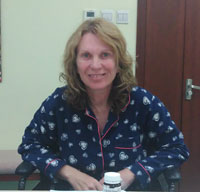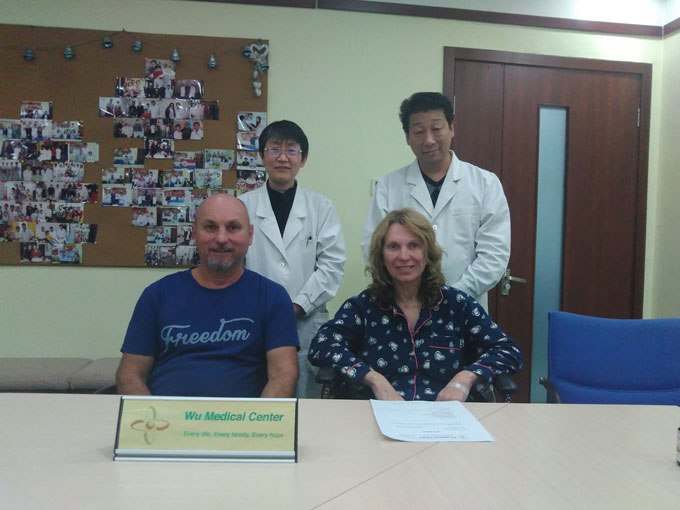Cheryl Dunkley-Multiple System Atrophy-(Australia)
 Name: Cheryl Dunkley
Name: Cheryl Dunkley
Sex: Female
Nationality: Australian
Age: 53Y
Diagnosis: Multiple System Atrophy
Treatment hospital/period: Wu Medical Center/15days
Before treatment:
Patient had urinary incontinence 4 years ago without clear reasons, she did not have a diagnosis at local hospital. She took bladder neck sling suspension surgery but that did not solve her urine problem and her condition got worse. 2 years before, the patient had slow movement, balance disorder and those symptoms increased, she had dizziness and postural hypotension. The patient was diagnosed as MSA and she took L-dopa. Now she had slow movement, poor balance control and she could not stand independently. She can roll over in bed, sit up slowly and she can walk few steps with the aid of a walker. She needed a wheelchair when outdoors. Her arm movement is clumsy and she needed help to dress or bathe. She can drink water and brush her teeth slowly. Whilst chewing and swallowing are fine, she does choke occasionally. Her speech is clear now but she noticed that her voice had some change. Recently the patient had dyspepsia and snoring at night and she started to use a non-invasive breathing machine when sleeping. Now she takes L-dopa and fludrocortisones while her condition is still declining. She found Wu Medical Center and after a medical consultation she came to China for the active treatment in our medical center. When she was admitted her mental condition was fine, her daily food intake had reduced, and she had difficulty with urination. One month before she had cystostomy and she had frequent diarrhea. She still needed to use the non-invasive breathing machine when she was sleeping.
Admission PE:
Bp: 135/97mmHg, Hr: 96/min. The skin mucosa had no yellow staining, bleeding spots or petechial. The superficial lymph node had no swelling and the pharyngeal had no congestion. The tonsils had no swelling. The respiratory sounds in both lungs were clear and there were no dry or moist rales. The heart sound is strong, with not obvious murmur. The abdomen is flat and soft, with no pressing pain, rebound tenderness or mass. Liver and spleen are normal. The hypogastrium has a bladder fistula. There was no edema in the legs.
Nervous System Examination:
She was alert and the facial expression was normal. The speech was clear but the sound was lower than before. Her memory, orientation and calculation ability were normal. Her pupils were equal in size and round, and the diameter was 2.5mm. Both pupils would react to light stimulus and her eyeballs moved normally. Her forehead wrinkle was symmetrical and she could close her eyes normally. Bilateral nasolabial sulcus was equal in depth. There was no dissymmetrical in the teeth. She could open her mouth and chew normally. She had no dysphagia. Her tongue had no tremor and could reach the cheeks easily. There was no air leaking when she blew out her cheeks. The muscle strength of arms was level 5. There was micrographia and obvious tremor in the fine movement. The muscle strength of her legs was level 4. She turned over in bed and could sit up slowly. She could walk with a walker, outdoor movement was dependent on a wheelchair. The muscle tone of her legs was slightly higher than normal. The tendon reflexes were active. Bilateral Hoffmman sign was positive, bilateral Babinski sign was neutral. The superficial and deep sensibility was normal. The bilateral finger-to-nose test was unstable. The rapid rotation test and finger-to-finger test were done slowly. The knee-heel-shin test was done clumsily. She was unable to stand when she closed her eyes, and she could not stand on one foot. The kerning sign was negative and brudzinski signs were negative.
Treatment:
Cheryl used a CPAP ventilator for a long time. The blood oxygen saturation stabilized between 95-98%. After related examinations, Cheryl was diagnosed with 1. Multiple system atrophy. 2 Multiple thyroid nodules. She received 3 neural stem cell injections and 3 mesenchymal stem cell injections to repair her damaged motor nerves and replace dead nerves with new injected stem cells, nourish nerves and improve blood circulation. She undertook rehabilitation training.
Post-treatment:
After 15 days of treatment, Cheryl has shown a good change in her exercise endurance. The range of breathing movement has improved. The respiratory sound of the left lower lobe is clearer than before. The snoring and dizziness have been alleviated and her speech is more fluent. The tremor of fine movement has decreased and the micrographia has changed. The finger-to-nose test was completed better than before. The Romberg sign was negative. She can now perform one leg standing posture for some time in a stable manner- left foot for 5s and right foot for 10s.

